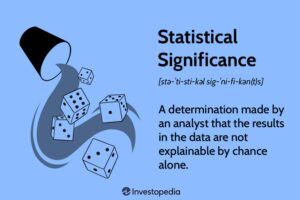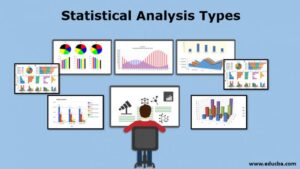
In the ever-evolving landscape of research and data analysis, the concept of statistical significance remains a cornerstone of scientific inquiry. As we navigate through 2024, understanding how statistical significance is shaping research trends can provide invaluable insights for analysts and scientists alike. This comprehensive guide delves into the current trends, challenges, and innovations surrounding statistical significance, offering a roadmap for those committed to rigorous and impactful research.
Understanding Statistical Significance
Statistical significance is a measure that helps researchers determine whether their findings are likely to be genuine or if they occurred by chance. It is typically assessed using a p-value, which quantifies the probability of obtaining the observed results under the null hypothesis (i.e., the hypothesis that there is no effect or difference). A p-value below a predetermined threshold, often 0.05, indicates that the results are statistically significant and unlikely to have occurred by random chance.
Emerging Trends in Statistical Significance for 2024
- Emphasis on Replicability and Reproducibility
One of the major trends in 2024 is a renewed focus on the replicability and reproducibility of research findings. The replication crisis, which has plagued various fields, underscores the importance of statistical significance in verifying results. Researchers are increasingly adopting practices such as pre-registering studies and sharing data and methodologies openly to facilitate replication efforts. This trend aims to enhance the credibility of scientific research and reduce the incidence of false positives.
- Integration of Bayesian Methods
While traditional hypothesis testing focuses on frequentist approaches, Bayesian methods are gaining traction in 2024. Bayesian statistics provides a framework for updating the probability of a hypothesis as new data is collected. This approach offers a more nuanced view of statistical significance by incorporating prior knowledge and providing a probability distribution for the effect size, rather than a binary significant/not significant outcome.
- Focus on Effect Sizes and Confidence Intervals
The emphasis on p-values alone has been criticized for promoting a dichotomous view of significance. In response, there is a growing emphasis on reporting effect sizes and confidence intervals alongside p-values. Effect sizes provide a measure of the magnitude of an effect, while confidence intervals offer a range of values within which the true effect is likely to fall. This trend reflects a more comprehensive approach to interpreting research findings and their practical significance.
- Addressing the Multiple Testing Problem
The multiple testing problem, where conducting numerous statistical tests increases the likelihood of finding at least one significant result by chance, is a significant concern. Researchers in 2024 are adopting more robust methods for addressing this issue, such as the Bonferroni correction and false discovery rate (FDR) procedures. These methods adjust the significance threshold to account for the number of tests performed, reducing the risk of type I errors.
- Adoption of Machine Learning and AI

Machine learning and artificial intelligence are transforming how statistical significance is assessed and interpreted. Advanced algorithms can analyze complex datasets and identify patterns that traditional methods might miss. These technologies are also used to simulate data and assess the robustness of statistical findings. As machine learning continues to evolve, it will play an increasingly significant role in shaping research trends and enhancing the accuracy of statistical significance assessments.
Challenges and Considerations
- Misinterpretation of p-Values
Despite its importance, the p-value is often misunderstood and misinterpreted. Researchers and the public sometimes equate statistical significance with practical or clinical significance, leading to potential overstatements of findings. Educating researchers on the correct interpretation of p-values and the importance of context is crucial for mitigating this issue.
- Ethical Implications
The pursuit of statistical significance can sometimes lead to questionable research practices, such as p-hacking (manipulating data or analysis to achieve a significant p-value). Ensuring ethical standards in research involves promoting transparency, pre-registering studies, and adhering to best practices in data analysis.
- Balancing Rigor and Practicality
While rigorous statistical methods are essential, researchers must also balance rigor with practicality. Overemphasis on statistical significance without considering the practical implications of findings can lead to research that, while statistically sound, may lack real-world relevance. Striking this balance is key to producing research that is both scientifically valid and practically useful.
Best Practices for Analysts and Scientists
- Pre-Registration and Transparency
Pre-registering research hypotheses, methods, and analysis plans before data collection enhances transparency and reduces the risk of bias. This practice also facilitates replication and helps maintain the integrity of research findings.
- Report Comprehensive Results
In addition to p-values, report effect sizes, confidence intervals, and the full context of the research findings. This approach provides a more complete picture of the results and their implications.
- Adopt Robust Statistical Methods
Utilize advanced statistical methods and tools to address issues such as multiple testing and data complexity. Staying informed about new developments in statistical techniques and technologies will help ensure the accuracy and reliability of your research.
- Promote Ethical Research Practices
Adhere to ethical standards in research by avoiding practices such as p-hacking and ensuring that your findings are reported accurately and transparently. Engage in peer review and seek feedback from the scientific community to uphold the quality of your work.
Conclusion
As we progress through 2024, the role of statistical significance in shaping research trends remains pivotal. By embracing new methodologies, addressing challenges, and adhering to best practices, analysts and scientists can enhance the rigor and impact of their research. Understanding and effectively applying statistical significance will continue to be crucial for producing reliable and meaningful scientific discoveries.



